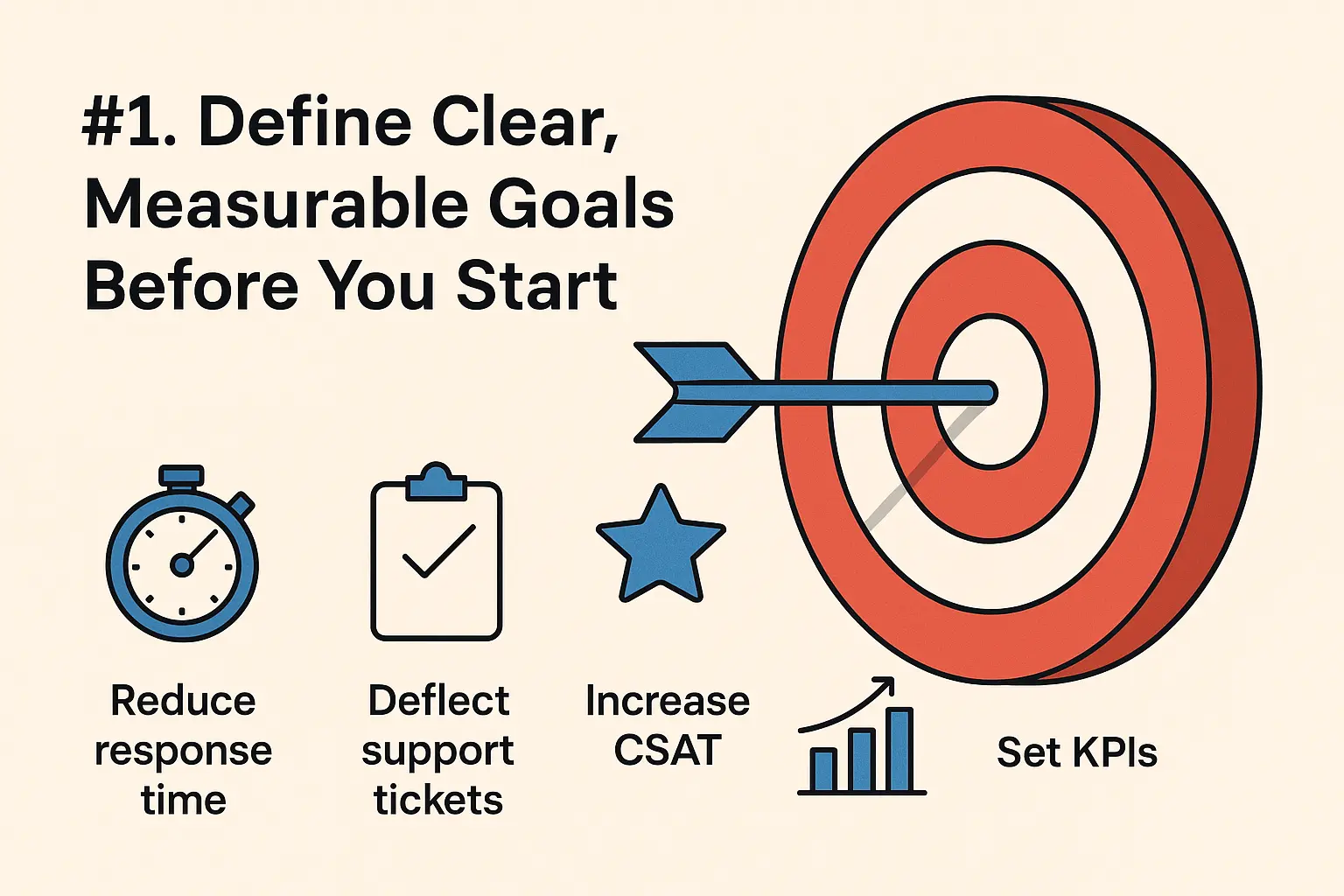10 Essential Steps to Integrate AI Chatbots Into Your Existing CRM to Boost Customer Satisfaction

5 mins read
🔟 Essential Steps to Successfully Integrate an AI Chatbot with Your CRM
Integrating AI chatbots with your CRM can revolutionize how you engage customers — improving satisfaction, reducing workload, and scaling support instantly. Here’s a step-by-step playbook to make it happen.
1. Define Clear, Measurable Goals
Before any technical setup, know what success looks like.
Ask yourself:
- Are customers waiting too long for responses?
- Is your team swamped with repetitive questions?
- Do you need better lead qualification?
Set measurable KPIs, such as:
- ⏱ Reduce first response time by 80%
- 🎫 Deflect 50% of tier-one support tickets
- 😊 Boost CSAT by 25%
Pro Tip: Align goals across departments. Sales might care about lead conversions, while support focuses on resolution time — but both should share unified success metrics.
2. Audit and Clean Your CRM Data
Your chatbot is only as smart as your data.
Run a data audit to:
- Remove duplicates and outdated records
- Fix inconsistent formatting (e.g., “US” vs “USA”)
- Complete missing profiles
Best practices:
- Standardize data entry fields
- Enforce validation rules
- Schedule recurring data hygiene checks
Why it matters: Poor data = poor bot performance. Clean data lets your chatbot personalize conversations and avoid embarrassing mistakes.
3. Pick a Platform with Native CRM Connectors
Avoid integration headaches by choosing a chatbot that plays nicely with your CRM.
Look for:
- ✅ Pre-built connectors (Salesforce, HubSpot, Dynamics, Zoho, etc.)
- 🧠 Custom data training (so it learns your FAQs, docs, and tone)
- 📈 Scalability (multi-channel support and growth flexibility)
- 🔐 Security (encrypted APIs, GDPR/CCPA compliance)
Shortcut: The right platform lets you integrate in minutes, not months.
4. Map Data Fields and Define Triggers
This is where chatbot magic meets CRM automation.
Do this:
- Identify conversation triggers → e.g., “Schedule a demo” → create a new lead.
- Define bi-directional data flow so your chatbot can both read and write to CRM.
- Build a field mapping blueprint for name, email, preferences, sentiment, etc.
- Set intelligent routing rules for human handoff when confidence drops or issues get complex.
Outcome: Seamless automation that turns chat events into actionable CRM updates.
5. Prioritize Security, Privacy, and Compliance
Don’t bolt on security — build it in from day one.
Checklist:
- 🔒 Use encrypted APIs (OAuth 2.0, JWT)
- 🧾 Follow all relevant laws (GDPR, HIPAA, CCPA)
- 🗑 Define retention/deletion policies for chat transcripts
- 👥 Implement role-based access — limit who can see what
Bottom line: Customers trust you with their data. Protect it like gold.
6. Train Your Chatbot on Real Conversations
Out-of-the-box bots feel robotic. Great bots sound human.
Train with:
- Historical chat logs and email threads
- Real customer phrasing and abbreviations
- Industry-specific terminology
Then continuously refine:
- Expand training datasets with real interactions
- Identify failed responses and retrain
- Add new intents and entities regularly
Also: Build a solid knowledge base covering policies, FAQs, and product details.
7. Design Personalized Flows Using CRM Data
Make every conversation feel tailor-made.
Ways to personalize:
- 🧍♀️ Use name, history, and preferences (“Welcome back, Sarah!”)
- 🎯 Offer context-aware help based on the page they’re viewing
- 👑 Segment customers — VIPs vs. new visitors
- 🧠 Remember past choices — don’t ask for info twice
Pro Tip: Platforms like IllumiChat make this simple — integrating chatbots trained on your proprietary data in under 10 minutes.
8. Implement Seamless Human Handoffs
Even the best AI needs backup.
Set clear triggers for escalation:
- Customer asks for a human
- Sentiment = frustration
- Confidence < threshold
- Issue involves billing/security
Ensure smooth transitions:
- Pass full context and chat history
- Use empathetic language (“Let me connect you with a specialist…”)
- Allow agents to monitor and jump in live
Goal: Make AI + human collaboration feel effortless.
9. Monitor, Measure, and Optimize Continuously
Integration is never “done.” Always iterate.
Track metrics like:
- Containment rate
- Resolution time
- Escalation rate
- CSAT and NPS
Then:
- Analyze failed conversations for gaps
- A/B test greeting messages and flows
- Gather real feedback after chats
- Audit data syncs regularly for errors
Think of it as: Continuous learning for both your chatbot and your business.
10. Train and Empower Your Team
Technology fails without human understanding.
Train everyone:
- 🎧 Support agents → when to intervene and how to use chat history
- 💼 Sales → how to prioritize chatbot-qualified leads
- 📊 Managers → how to interpret analytics dashboards
Also:
- Document SOPs for escalations and overrides
- Build feedback loops between agents and developers
- Run ongoing refreshers as features evolve
Culture tip: Position AI as an assistant, not a replacement.
Final Takeaway: Integration = Transformation
When done right, AI chatbot + CRM integration delivers:
- Faster responses
- Lower costs
- Happier customers
- Smarter teams
The winning formula:
✅ Start with clear goals ✅ Keep your data clean ✅ Map your triggers ✅ Never compromise on security ✅ Train, personalize, monitor, and adapt
With tools like IllumiChat, this transformation can happen in minutes—not months—helping you scale customer experience without scaling headcount.
Ready to Transform Your Support with AI?
Join thousands of teams already using IllumiChat to deliver faster, more accurate support. Start your free trial today or subscribe for the latest AI insights.
No credit card required • Setup in under 30 minutes • Cancel anytime